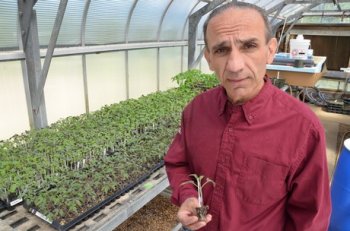
Masabni, a Texas A&M AgriLife Extension Service horticulturist in Overton, receives phone calls every spring from beginning gardeners and farmers who are ill-prepared to deal with pests, diseases, weeds and many other problems that can stunt or decimate a crop, he said.
The tactical gardener reacts to problems, while a strategist plans to avoid problems when possible and address them quickly and effectively when they are unavoidable, he added. “Planning ahead can improve yields. It can mean the difference between total loss and 100 percent success.”
He said that the strategist has multiple sources for all their needs, from seed and tools to pesticides, fertilizers and materials, such as T-posts and chicken wire, he explained. They should have basic tools and materials on hand to address a problem as soon as it’s found. Strategists plan ahead by considering crop rotations in advance and base decisions on soil health. They also take notes each season to improve their chances next year.
Soil is the most important component to a strategic gardener’s plan, Masabni said. Testing a soil sample for a small garden or multiple samples for larger fields where soils can differ is an important first step to any plan. The gardener feeds the soil and the soil feeds the plant, he said.
Masabni suggests testing the soil each year, which will identify what additives, such as lime, fertiliser or nitrogen, will give the soil what it needs to grow specific crops. “You have to know what you are working with,” he said. “It’s important because soil health is 50 percent of the battle when you’re talking about dealing with disease or weeds and helping a crop reach its potential.”
Having the right tools on hand to tend a garden or field helps reduce prolonged exposure to problems such as disease or pests, but a management plan can address possible problems before they occur, he said.
Masabni had a problem with stinkbugs in his tomato plants one year and created a plan to control them the next year. That’s how notes and recording the good, bad and ugly of each season can pay dividends, he said.
Knowledge is a powerful tool for a beginner gardener, Masabni said, but it’s easier to educate yourself during dormancy periods by reading books and gardening periodicals or by discussing options and opportunities for next season with AgriLife Extension agents and specialists.
Right now is a good time to establish a plan to deal with pest season, he said. Growers should be educating themselves about various insect pests, from squash and stinkbugs to corn earworms. Masabni said growers should know what types of insects individual plant types might attract, the pest’s typical life cycle, the signs of infestations and how to address them in the egg stage.
In small gardens, addressing eggs could be as easy as squishing them, he said. “A good strategist, or a well-prepared gardener, should have the pesticides on hand, the sprayer clean and calibrated, and should scout all the time,” he said. “A well-prepared gardener can start spraying in about ten minutes and address the problem effectively.”
Masabni said a strategist gardener should be planning for the fall garden now that spring gardens are in the ground.
For example, gardeners should order seeds now, check pesticide inventories and plan crop rotations using a different crop family, not just a different crop name. Also, growers can solarize gardens in July to control nematodes, weeds and insect eggs before planting fall gardens.
“Be a strategist, not a tactician,” he said. “All successful gardeners and commercial producers are strategists, whether they know it or not, because they plan ahead.”
Masabni is a vegetable specialist and author of 'Easy Gardening in Texas'.
Photo: Dr. Joe Masabni, Texas A&M AgriLife Extension Service horticulturist, holds a Brandywine heirloom tomato grafted on Maxifort rootstock. (Texas A&M AgriLife Extension Service photo by Adam Russell)
Source: Texas A&M Agrilife



 Classifieds
Classifieds

